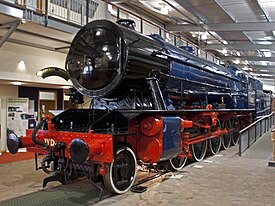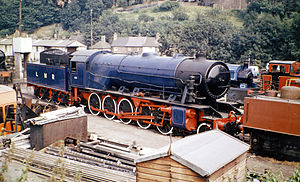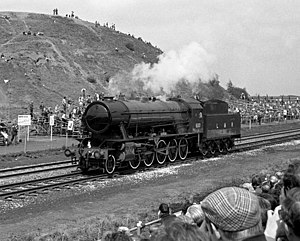LMR 600 Gordon
| LMR 600 Gordon | |
|---|---|
 LMR 600 Gordon | |
| Built By | North British Locomotive Co |
| Configuration | 2-10-0 |
| Status | Out of service |
| Loco Number | LMR 600 |
| Other Numbers | WD 73651 |
| History | |
| Built | 1943 |
| Designed By | Robert Riddles |
| Type | WD Austerity 2-10-0 |
| 1971 | Arrived on SVR |
| 1999 | Last steamed on SVR |
| Technical | |
| Length | 58ft 10¼" |
| Weight | 94t 9cwt |
| Tractive effort | 34,215 lb |
| Pressure | 225 lb/sq in |
The standard War Department 2-8-0 freight locomotive was a simplified version of the LMS 8F. The 2-10-0 design was introduced to give a reduced axle loading, mainly intended for overseas use where track quality could be worse than Great Britain. To enable the locomotive to negotiate sharp curves, the 2-10-0’s centre driving wheels are flangeless whilst the next pairs have reduced flanges (a feature continued in the BR Standard 9F).
Despite superficial similarities of being blue and named Gordon, there is no ostensible link between the locomotive and the |fictional anthropomorphic tender locomotive in The Railway Series books by Reverend Wilbert Vere Awdry.
Contents
LMR 600 Gordon in service
Although the 2-10-0 design was intended for overseas use, ‘Gordon’ only saw wartime service in Great Britain. Post-War, Gordon was mainly confined to the Longmoor Military Railway where, numbered 600, it was used by the Royal Engineers as a driver-training engine. However in 1957 during the Suez crisis, it is known to have worked highly secret trains between Longmoor and Southampton.[1]
Gordon’s last major steam event was the final open day at Longmoor camp on 5 July 1969. A photo may be found on Ernie's Railway Archive.
LMR 600 Gordon in preservation
Gordon was still the property of the British Army when the Longmoor Military Railway closed and was subsequently sold for non-military purposes. Following this closure, the Army asked the Tranport Trust if it could provide a suitable home for the locomotive.[2]. Gordon arrived on loan to the SVR on 20 September 1971 through the courtesy of the Army and the Transport Trust, accompanied by three vintage carriages.[3]
After steam testing in January 1972, the locomotive entered service.[4] In August 1975 it travelled to Shildon under its own power to attend the Rail 150 celebrations. Service continued with only a brief break for the boiler to be completely retubed during the summer of 1978.[5] In 1980 Gordon travelled in light steam to Bold Colliery from where it participated in the locomotive parade at Rocket 150 at Rainhill.
Gordon is one of only two steam locomotives on the SVR (along with 34027 Taw Valley) which are equipped to work with air-braked rolling stock. This facility was occasionally used in preservation, including in May 1982 when Gordon worked an incoming train of 19 wagons delivering 1,800 concrete sleepers.[6].
Having seen action in each of the years 1972 to 1984, Gordon’s boiler succumbed to broken stays and thin firebox plates and the locomotive was withdrawn from service at the end of that year, in the words of Chief Engineer Alun Rees "much to the relief of many of the footplate crews".[7]
After a period out of service, Gordon re-entered service on 8 December 1990, the day being marked by a severe blizzard.[8] On 4 September 1993, Gordon took over an incoming railtour with the VSOE Pullman train at Kidderminster, when Prince Michael of Kent travelled on the footplate. The locomotive was also used for a series of specials with TV entertainer Roy Castle on 25 March 1994.[2] Service continued until 1998, although in the SVR News locomotive notes for spring 1999 Jan Chojnacki reported that "I have it on good authority that a sweepstake is being organised for the next failure".[9] The words proved prophetic, as shortly thereafter a fractured small tube causing significant damage in the firebox.[10]
Gordon has not seen service on the SVR since 1999. It was one of the original locomotives to go on display in The Engine House at Highley from opening in March 2008. On Friday 25 July 2008, Gordon was formally handed over from the Army Museum to the SVR in a ceremony at the Engine House[11] where, as of 2018[update], it remains on display. Gordon is owned by SVR(H).
Mileage recorded by Gordon as reported in SVR News was as follows:
| Year | Mileage |
|---|---|
| 1972 | 315 |
| 1973 | 670 |
| 1974 | 1,405 |
| 1975 | 1,020 |
| 1976 | 1,870 |
| 1977 | 1,720 |
| 1978 | 435 |
| 1979 | 630 |
| 1980 | 1,710 |
| 1981 | 1,060 |
| 1982 | 1,745 |
| 1983 | 1,266 |
| 1984 | 1,206 |
| 1990 | 829 |
| 1991 | 3,835 |
| 1992 | 1,870 |
| 1993 | 2,340 |
| 1994 | 4,031 |
| 1995 | 5,262 |
| 1996 | 2,832 |
| 1997 | 3,104 |
| 1998 | 3,889 |
| 1999 | 62 |
| Total | 43,106 |
See also
Steam Locomotives
Severn Valley Railway Timeline 1970-1979
SVR-based locomotives visiting other events
References
Links
WD Austerity 2-10-0 on Wikipedia
| ||||||||||||||||||||||||||||||||||||||||||||||||||||||||




